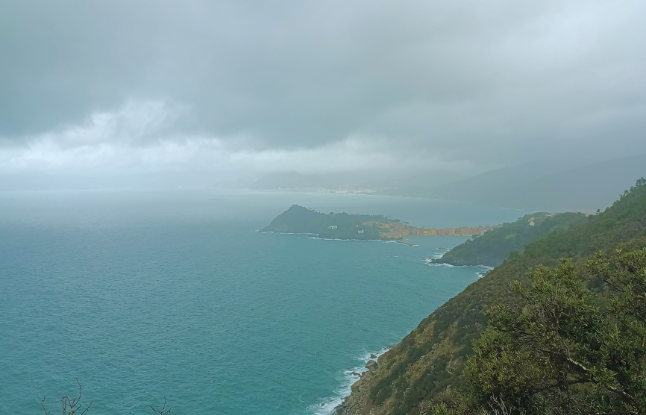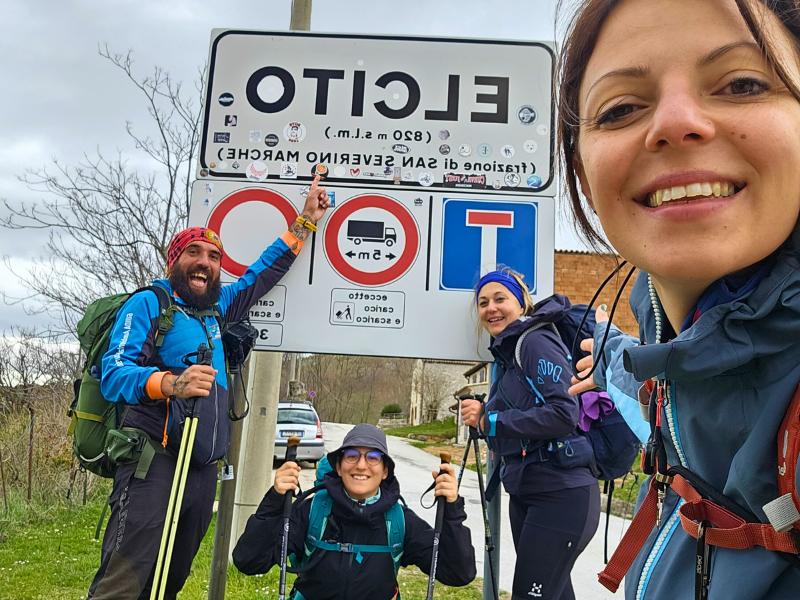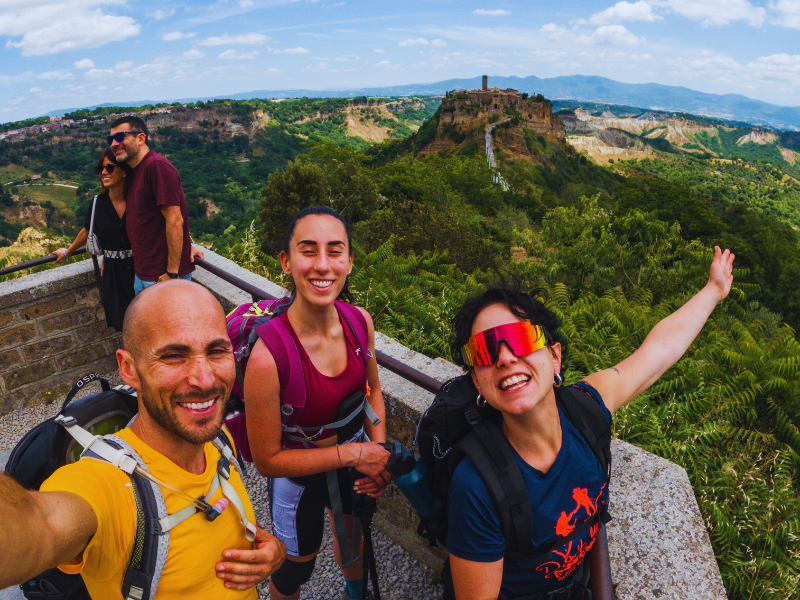From the heart of the Parma plains to the brackish scents of the Ligurian Sea: in this diary of a new trek, William tells us about his seven days along the Via Marialonga, 150 kilometers among ridges, forests, ancient villages and many encounters that smack of community. It’s not just a trek: it’s an inner journey, made of fatigue, wonder and reflection, traversing constantly changing landscapes and often forgotten territories. This diary recounts a journey of tough climbs, surprising forests, persistent rain and unexpected encounters. A piece of Italy that changes with every step, and leaves something deep inside.
Want to tell our community about your walking experience? Write to us at info@camminiditalia.org and we will provide you with all the information to share your adventure. Or, join our Facebook Community and post your story directly!
And to make sure you don’t get lost along the way, download the Cammini d’Italia app before you leave! You’ll have access to numerous GPX tracks of Italian walks and can get your bearings easily, even without a connection. Find out more at this link!
Introduction
Today I want to tell you about the 150 kilometers I traveled to take me from the lower province of Parma to the wooded beaches of the Ligurian side, along a succession of damnably diverse environments and vegetation: the Via Marialonga. A path that starts out winding through the oak and beech forests of the Emilian Apennines, ending up among black pines and tamarisk in quantity, along with prairies of heather, endless chestnut groves and pure citrus groves. The scent of those lands was already intense in this rainy early spring, who knows what a unique experience it must be even just a month from now.
Along the way I was greeted (almost) everywhere with great human warmth. Previously, as a tourist, I had obviously experienced the kindness of others, but I still did not know this mix of interest and curiosity about myself. In comparing myself with those who have been walking the paths for many more years than I have, it became apparent that this has everything to do with the figure of the pilgrim, armed with a lumbering stick, muddy boots and a backpack on his or her back.
For this kind of adventure, a well-equipped backpack makes all the difference. The First Walk Guide can help you choose the essentials.
He is not on vacation, but is on a journey, as much interior as exterior, and this still arouses an ounce of curiosity in those who meet him. The pilgrim comes from afar, knows toil and hardship, and brings with him his own baggage of thoughts. All this prompts many to want to have a word, to ask why you are doing this or what you are looking for in this journey. These conversations go far beyond simple findings about the weather, and fill the heart with joy and trust in others. Well, let’s cut to the chase: here is my honest diary of these six days.
Stage 01: Fornovo – Pellegrino Parmense
18.8 km – +796 m. / -537 m.
This walk begins with a day full of increasingly spring-like landscapes, “foraossa” wind and lots of ridge trail. At the start, it is worth stopping to visit the Romanesque parish church of Santa Maria Assunta, one of the most beautiful I have seen in this style.
After crossing the Taro River, the road soon becomes a path and, with a short but intense tear, we gain the first panoramic ridge. From here, we can get a good view of both the Ceno and Taro valleys on our left and the plain with Parma on the right. For much of the day we will stay on ridge trails like this, extremely scenic but also devilishly exposed to the sun and wind. Today’s freezing, piercing breeze helped keep my legs going smoothly.
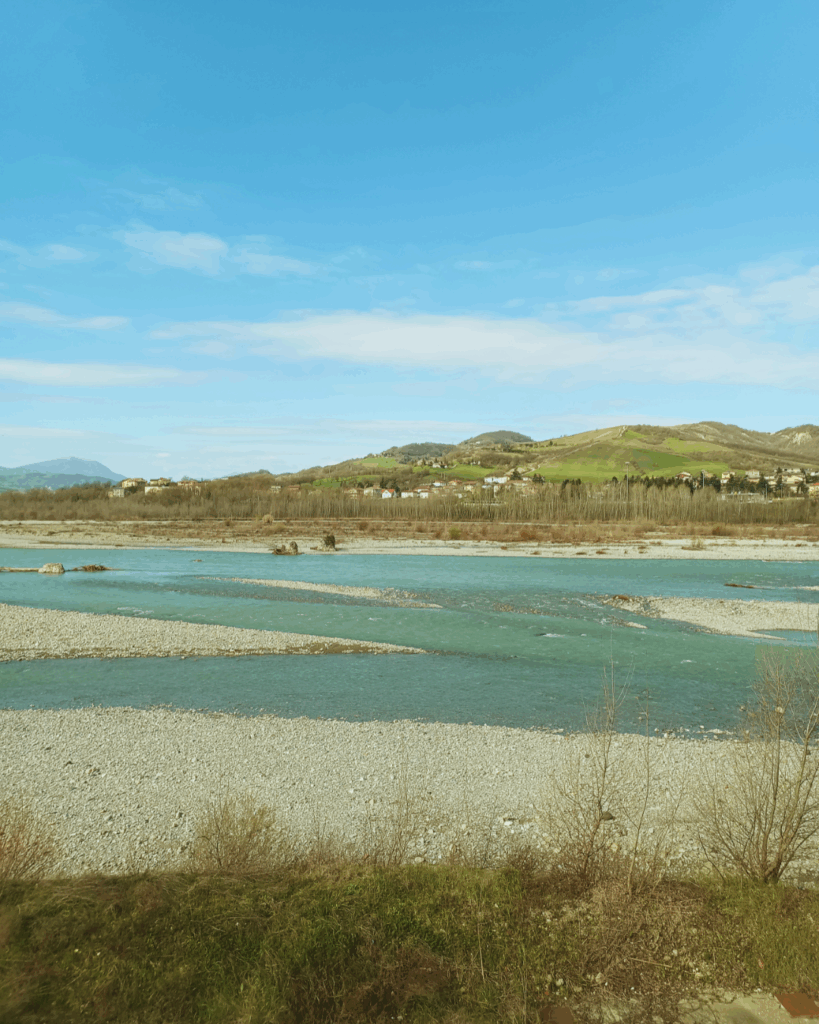
Continuing on, we skirt the ruins of Roccalanzona Castle, a truly absurd sight, clearly the Emilian version of Colle Vento. The peculiarities don’t end there, because on our way to Monte Pelato we encounter two bare black ophiolitic rocky outcrops, jutting out huge from the gentle contours of the hills: these are Pietracorva and Pietranera, names as apt as ever to describe them.
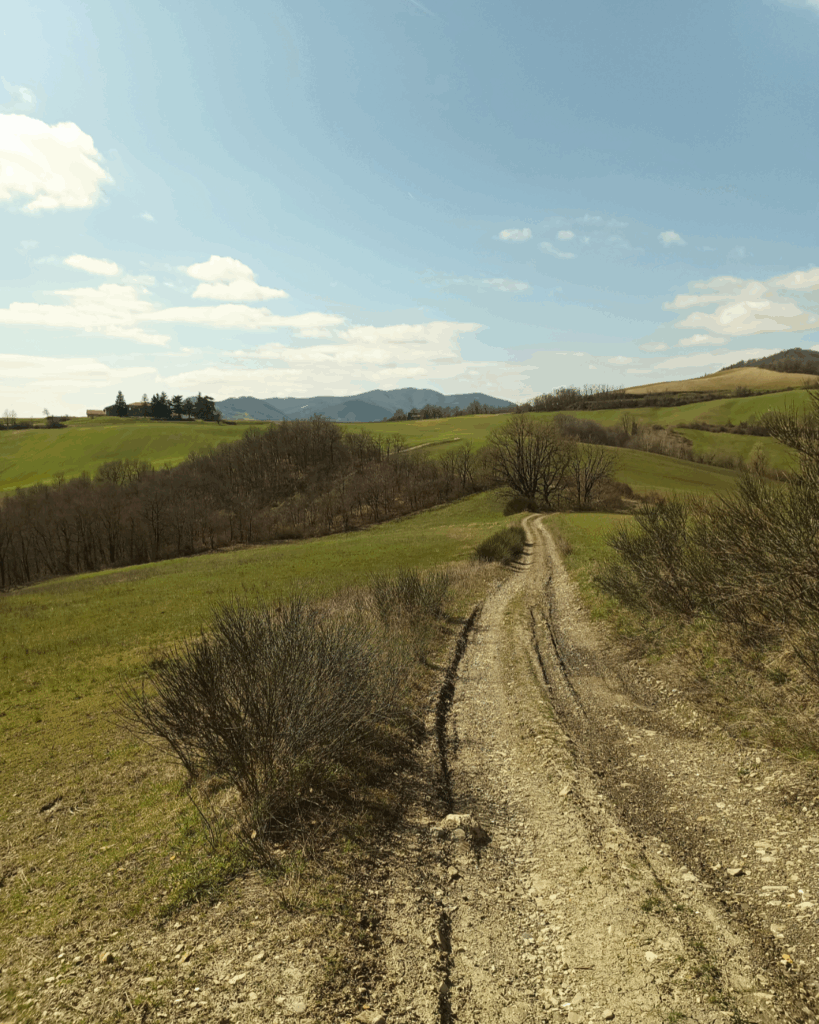
After the last climb to the church of Mariano, the road descends gently and in a couple of kilometers we are in Pellegrino Parmense. Although it is sparsely stocked with groceries in which to stock up, the beautiful hostel of San Francesco is located here. Founded as a convent in the 15th century and first becoming a hospital and then a middle school, the entire building was restored in 2000 and is now a modern structure, inside which you can still see parts of the frescoes. Recommended. Simple dinner at the Hotel Sole restaurant and then straight to bed, which tomorrow I have a double leg ahead of me.
Stage 02 and Stage 03: Pellegrino Parmense – Bore – Bardi
34.5 km – +1,425 m / -1,221 m
Double stage today, to make the knees crunchy just right. The difficulty in finding sleeping quarters in Bore, along with the bad weather on the way, prompted me to choose to combine two stages that were already not very long in themselves. Departing from Pellegrino, we go very quietly to Iggio, just to warm up a bit on these still wintry mornings. From here we leave the paved road to throw ourselves into well-muddied meadows and woods, until we see the church of Pozzolo, on its rocky outcrop. This little village is absurd: in some places it seems to have stood still from the last century, and it is worth taking a moment to visit.
From here we climb Mount Canzolino, with its broad, flat, marshy peak, and then descend to Bore. Better to take advantage of the services in the village for food and water supplies, because now the hard part begins. Having passed the “seven sisters,” we leave the road and hopes behind to enter the long wooded trail towards Mount Carameto. The ascent gets tough, but the constant fords and mud puddles camouflaged on the trail also make the ascent slow and challenging. Icing on the cake: at the highest part the loggers have taken out everything – trees, signs and trail. It’s a matter of using the GPS to navigate your way out of “this quagmire” and take the path that steeply descends to the Monte Pelizzone pass.
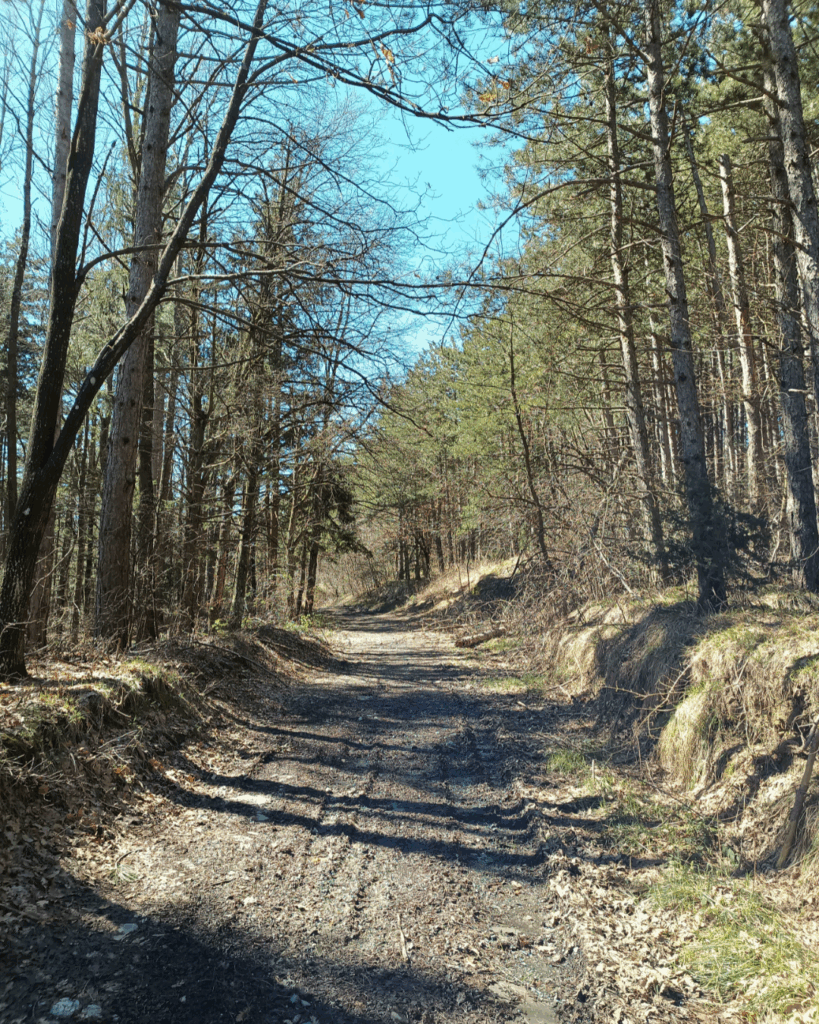
It is precisely in situations like this that you bless the free Cammini d’Italia app: offline tracking, accurate map, and zero risk of losing your way. Download it here!
After crossing the pass, we continue to descend toward Bardi along a beautiful scenic road that offers us glimpses of the Ceno Valley and the Barigazzo mountain complex. In this stretch there are not a few herds of Bardi cows and horses, so watch out for free dogs that may come your way. One last cursed ford, followed by a curious snatch to the social dairy, and Bardi with its huge fortress appears before us.
The medieval village offers several B&Bs and restaurants in which to refresh, but as a good pilgrim I managed to find a place at the lodging provided by the parish of the Blessed Virgin. If you settle for a bed, this place is for you.
Tonight dinner is well deserved.
Stage 04: Bardi – Compiano
22.6 km – +744 m / -813 m
Today is an amphibious stage, full of interesting fords and often accompanied by the roar of water. From Bardi, we first descend to the height of the Ceno stream and walk along it among willow thickets, greenish pools and squawking ducks. Since we are walking right at river level, every now and then the path goes below the water’s surface, but who are we to mind? In fact, it’s a good opportunity to wash all yesterday’s mud off our boots.
At the bridge at Mulino dei Belli we leave the Ceno to start up the Toncina stream, following a road that soon becomes a path. Here it is really worth enjoying the obvious difference between the forest on the slopes of the valley, mostly oak and beech, and that of the riparian belt, composed of willows, hazels and maples. With a tiny detour, one can visit the abandoned village of Ca’ Scappini, which, like every ruin on my way, requires thorough exploration.
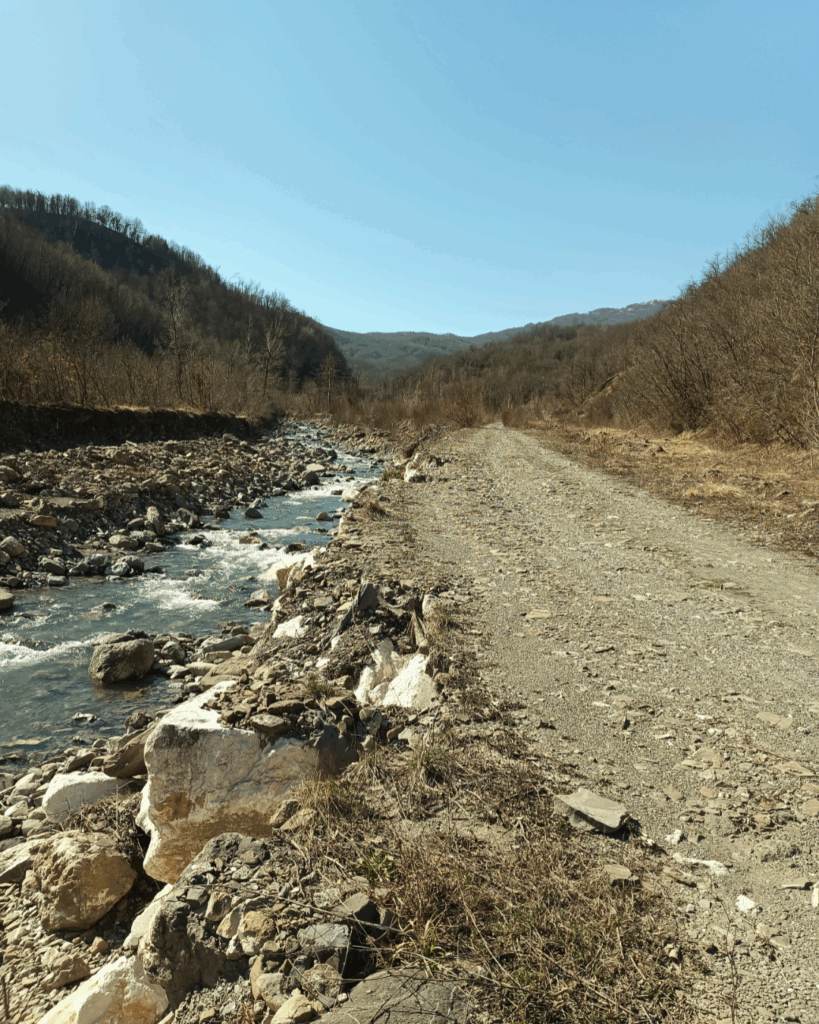
With a merciless tear up through the woods, we reach first Cereseto and then the small village of Farfanaro, a really interesting place, full of unique views: even just the fountain and the stone wash basins along the main road fully repay the effort to get there. From here we take the newly opened CAI trail, freshly painted and full of streams to ford, and pull uphill to Colla Pass.
From the pass, unfortunately, the magic of the trail is gone, and a long descent on asphalt road begins among woods that have just been cut down for wood. The sight of two deer rummaging through what remains, clearly visible even from a distance since they lack the shelter of vegetation, slaughtered me. The descent continues inexorably through fields, meadows and stables until the outline of the massive castle of Compiano becomes clearly visible, contrasting with the Taro River behind it.
I stopped slightly before Compiano, at the Agriturismo Le Carovane, because I wanted to see this stud farm in which they offer horseback riding or real day hikes for the more experienced. The two Maremmani at the entrance look like bears, but they are really good and used to people, so don’t panic.
At the farmhouse you can dine in, but their highlight is breakfast: jars of homemade jams from which to fish, fresh yogurt of their own making, crusty bread, brioches for the lurid and more. I swear I didn’t want to get up from that table, but I couldn’t get anything else to stay in my stomach.
Stage 05: Compiano – Varese Ligure
31 km – +1,103 m / -1,200 m
Today we are devaluing in Liguria! Too bad about the weather, which prevented me from seeing all the sights of this pleasant, well-altitude stage. So far, and despite the rain, it has been my favorite. At the start, we cross the Taro in the direction of Isola, where a well-stocked supermarket solves our lunch and snacks for the whole day. Past the built-up area, we begin to climb slowly up the long trail to the Cento Croci pass. Walking through a mossy green forest and past tiny villages, we arrive at Tarsogno, the first sizable hamlet.
Well, it may be more than just a group of houses, but to me it felt like the protagonist of 28 Days Later wandering around a deserted and abandoned London. Having passed (in silence) the village, we took the path to Goro and crossed the beautiful fir forest that stretches to Pratolungo, a perfect stop for those who wanted to stop for a picnic. Another half hour uphill on the road and here we are at the Cento Croci pass, from which there should be a beautiful view. Too bad that today the clouds were so thick and low that they prevented me from seeing even the wind turbines at my side.
From here, we continue on a beautiful rocky trail that takes us even higher, through woods and pastures, until we really start the descent after Mt. Ventarola. Now we have to lose all the elevation before we reach our destination, and we do it really fast but on scenic and easy trails. The village of Varese Ligure is a place full of contrasts. Here a colorful old town, built in a circle around the castle, clashes with the forest of “For Sale” signs hanging everywhere, and it is easy to get caught up in a general feeling of neglect and abandonment.
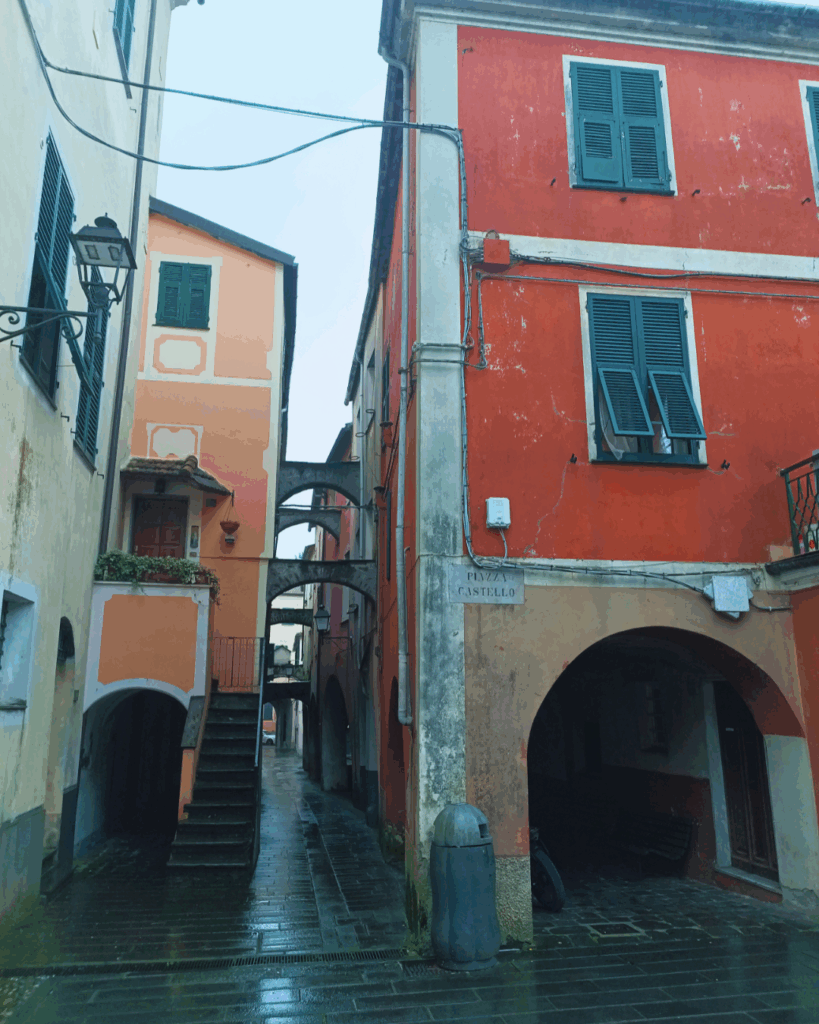
I was disappointed, because the town deserves to be explored before going to the room, but not all the sights are well maintained. The Amici Hotel, in the center of town, in which they are used to accommodating people on their way, is excellent. It is possible to dine and have breakfast here, but the village is very well stocked and does not let us lack anything.
Stage 06: Varese Ligure – Bargone
29.5 km – +969 m / -1,006 m
Today was an ominous weather day, with deluge in the morning and low clouds in the afternoon. Unfortunately, I managed to see very little along one of the most beautiful stages of this camino. From Varese Ligure we immediately begin to climb in the direction of Mount Cucco, but on this stretch the thing I watched most was the path, to avoid getting into puddles of water and mud. Continuing uphill, we arrive at the half-abandoned village of Valletti, a place that straddles the line between fascinating and eerie, hard to describe without seeing it.
Past this glimpse, still climbing relentlessly, the trail begins to open up and gives us a decidedly scenic ridge trail, at least on a clear day. From Mount Porcile to Bocco Pass I was always in the cloud, but we could sense views in all directions. It would have been wonderful to be able to get a good view, already from here, of the mountains plunging into the sea.
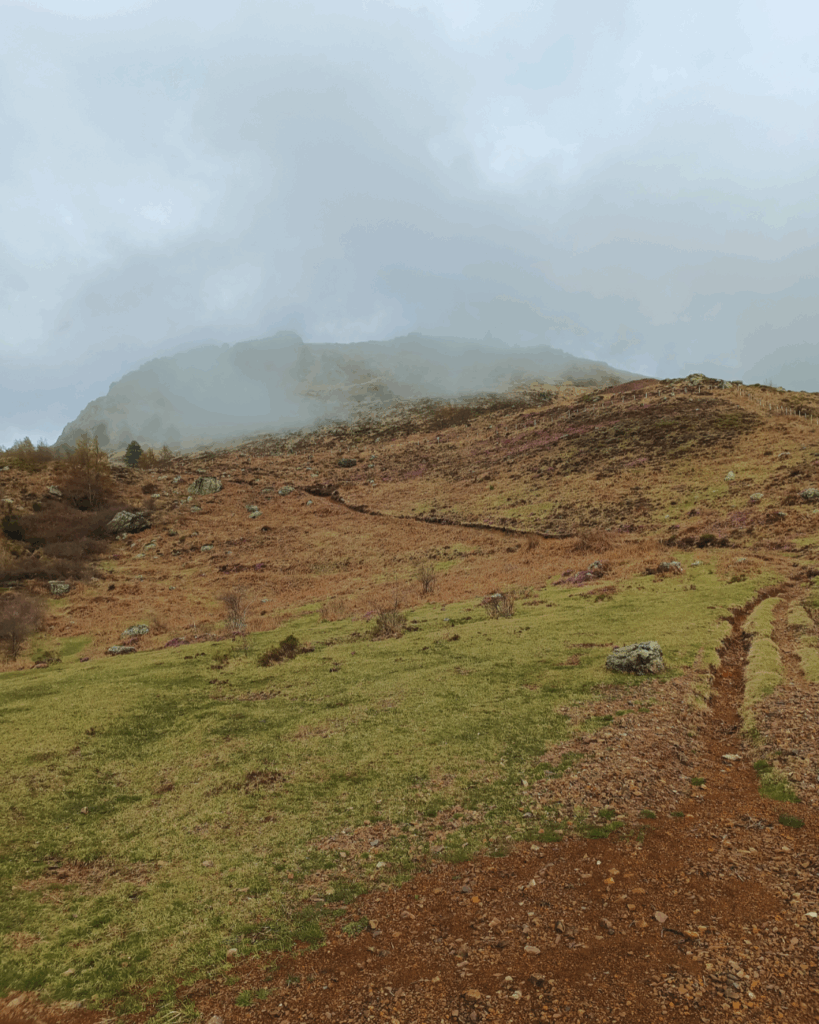
From the pass begins the long, steep descent to Bargone. The real spectacle here is the nature that surrounds us: we go from low meadows of flowering heather and helichrysum to an enormous chestnut grove that stretches across the ridge. Descending further, we enter full Mediterranean scrub, with an abundance of black pine, maritime pine, sylvestris, flowering tamarisk and laurel. Again today, and despite the weather, the scent in the air was really strong.
Once at my destination, the cosy village of Bargone should definitely be explored, with its small, twisted carruggi that run practically vertically up the mountainside. There is no shortage of hospitality at “Ca da Ciassa,” and an entire house with a fully stocked kitchen and bathroom is made available to me. Top. There is a tavern and a home restaurant in the village, but it is best to make reservations. I worked out dinner at the grocery store below the house. Can you see the sea from here? Who knows, neither today nor tomorrow will the weather allow me to find out. It will mean that I will have to return to this path soon, perhaps no longer alone.
Stage 07: Bargone – Sestri Levante
12.6 km – +419 m / -689 m
What did I learn from this day? That Liguria is very steep and rocky. That’s why, when it rains, it gets all freakishly slippery and hard on impact. Final stage of this walk and, weather permitting, also among the most scenic. Walking through the fragrant Mediterranean scrub, popping out every now and then to find exceptional views of the sea, is priceless. In the morning it is possible to have breakfast in the tiny multi-license grocery store in Bargone. Fortunately, such emporiums still exist in these small mountain villages, symbiotically linked to ensure each other’s survival.
From Bargone we take the trail that cuts steep tree-lined ridges to Casarza. A little up and down in the pine forest, and much of the day’s elevation gain is well and truly overcome. Here the trail climbs vertically again toward Verici, but on rainy days like today it is possible to cut this dangerous stretch by riding along the bike path toward Riva.
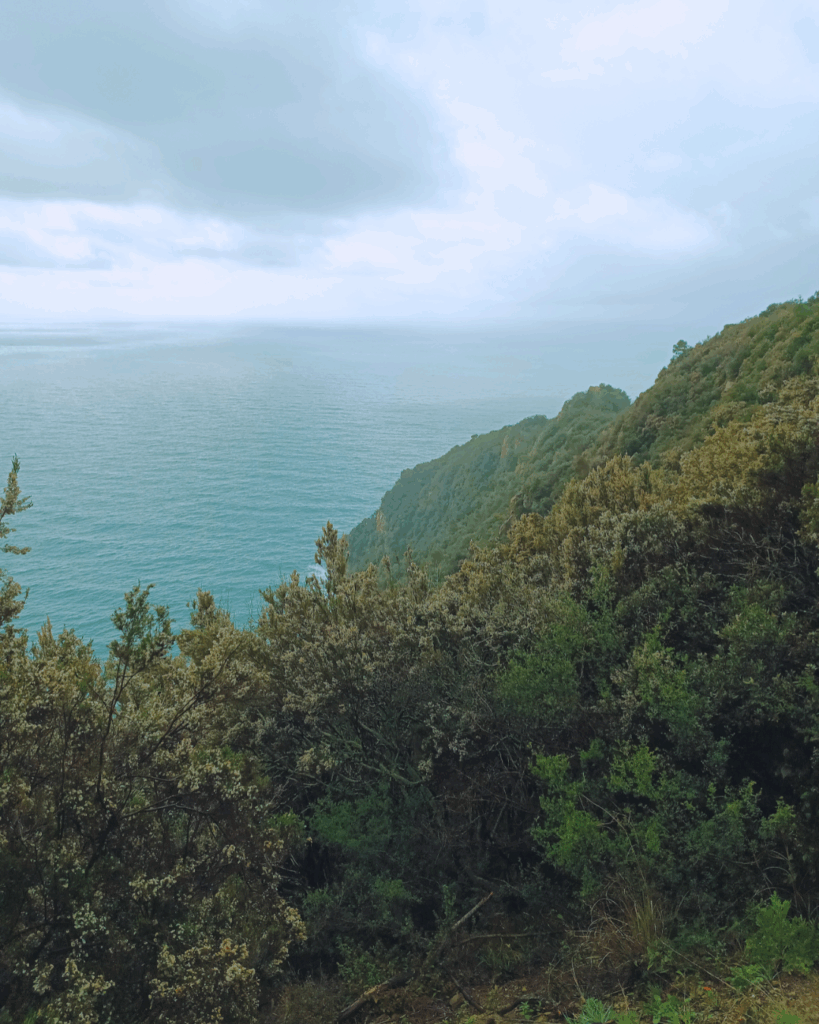
Now our goal is the Saracen tower of Punta Manara, which, however, is not at sea level at all. In no time, we have to grind the 190 m of positive elevation gain to the tower. However, the snatch is abundantly repaid by the absurd view that opens up already from the side glimpses, even before we get to the viewpoint. Moreover, walking among fragrant pines and twisted tamarisk is a wonderful experience.
From the tower, to our right, the view goes into the Ligurian Gulf with its colorful towns and ports. Despite the water and the clouds, I was able to see as far as the Portofino headland today. Who knows what it must be like when it is sunny and the air is clear. Sestri Levante is clearly visible below us, and in half an hour it can be reached by crossing the scrubland of Mount Castello.
I thought the town was very interesting, but the bad weather prevented me from visiting it properly, including the harbor. The good thing about this short stage is that it purposely leaves the whole afternoon free to take a trip to Sestri, so we will need to catch up soon. Wet walk, lucky walk? I would say so. Like any environment, different climates hide some pitfalls behind their charms, but it’s all part of the experiences we take home. Along with the desire to return, of course.
From the shortest routes to the great traverses, our Atlas of the Paths of Italy collects more than 100 trails. A true travel companion for finding the perfect route and setting off without a care in the world. Discover it and choose your next path!

